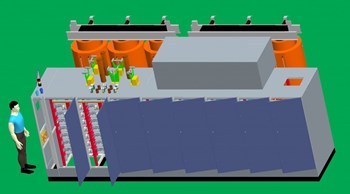ITER NEWSLINE
-
ITER's electron cyclotron system reviewed
ITER's electron cyclotron system reviewed

Manufacturing can now begin on two of the eight main high voltage power supplies (6 MW each) for the ITER electron cyclotron system. Once delivered, they will be installed in the ITER Radio Frequency Building.
The European Domestic Agency for ITER, Fusion for Energy, has held a Final Design Review for the electron cyclotron system—one of the heating systems that will help to bring the ITER plasma temperature to 150 million degrees Celsius.
Manufacturing can now begin on the power supplies for the electron cyclotron system under European procurement responsibility.
The electron cyclotron power supplies convert electricity from the grid to regulated direct current and voltage at 55kV nominal, from which the ITER
gyrotrons will generate electromagnetic waves. Europe is in charge of procuring eight sets of electron cyclotron power supplies with a total rated power of 48 MW. Another four sets will be supplied by India and the ITER Organization.
While many of the ITER components are manufactured by the Domestic Agencies on the basis of ITER Organization final designs, in some cases, ITER provides the functional requirements only. This is the case for the electron cyclotron system, for which Europe is responsible for the design and therefore also for conducting the Final Design Review.
The Final Design Review of the electron cyclotron system was led by an official review panel chaired by Michel Huart, the former head of power supplies at JET. In addition to international technical experts, representatives from Fusion for Energy and the ITER Organization with expertise in the areas of safety, control, quality assurance, electrical systems, gyrotrons, cooling, and buildings also attended, as well as representatives from Ampegon (the supplier selected
last year by Europe to design, manufacture, install and commission the electron cyclotron power supplies) and gyrotron developers from Russia and Europe.
No major issues were identified and it is expected that all open questions will be clarified in the following weeks. Manufacturing will begin in 2015 for the first set of electron cyclotron power supply systems.
Read the full article on the European Domestic Agency website.
return to the latest published articles







